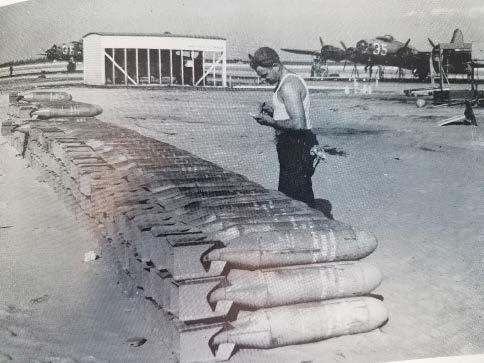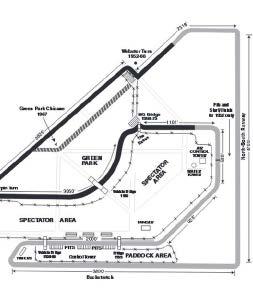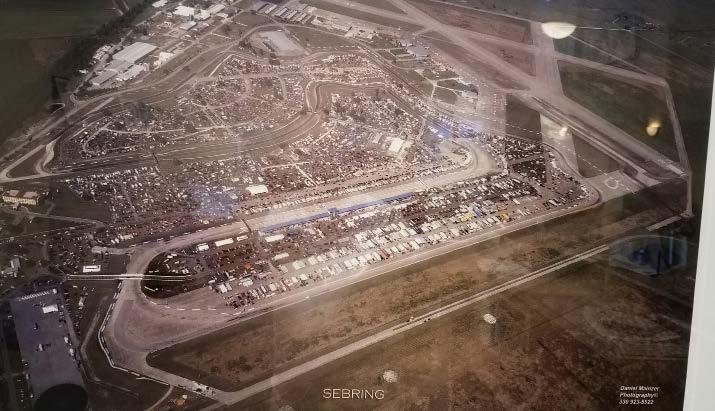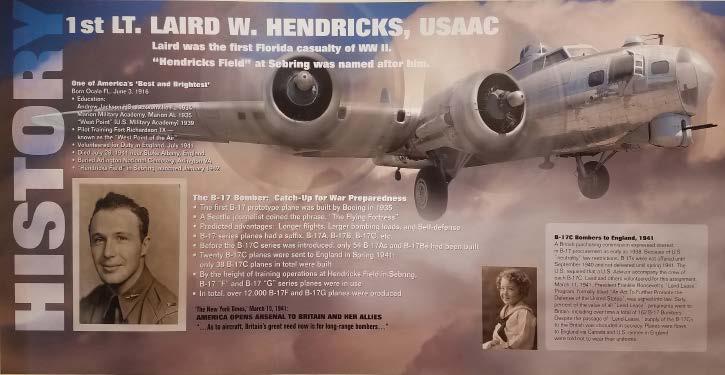
8 minute read
History of Sebring Race Track
from Die Porsche Kassette
by Pcagcr
HISTORY OF SEBRING RACE TRACK AND HENDRICKS FIELD
STORY BY MIKE TARTER, PHOTOS BY COLOUR TECH SOUTH
In 1999, the Sebring pits, tower and viewing suites that we utilize were under construction. So, the Sebring Club Race that year was held in the Green Park area within turns 4 through 12. While walking around between sessions, I noticed a drainage manhole cover. Cast into the rusty steel was some identification writing: “Mclean Iron Works - Palatka Florida 1941”. What?! Wow, that’s old. I marveled over this old steel, and then realized I was looking at a part of the original airfield built during World War II. I’ve been driving at Sebring track events since 1983, and I sort of knew the racetrack had originally been configured on an airfield, but I hadn’t really thought about the history of the track. I later looked at aerial photos and recognized that some that we enjoy today is remains of that airfield. I was intrigued; I got reading.
It goes back to 1940. War had been raging in China and in Europe for several years. It was likely the U.S. would be at least an indirect participant. We were already supplying equipment to our allies via the LendLease program. Sebring city leaders foresaw the US would need training bases. They proactively bought 9,200 acres of sandy, palmetto-covered, marshy, Florida prairie land about seven miles southeast of the city of Sebring. This larger than immediately necessary area was then offered to the U.S. War Department, with a 99 year lease at $1.00 per year.

After inspections and considerations for power, water, weather, rail service and road access, on June 13, 1941 the War Department announced that this site was to become a Basic Flying School. By the end of 1941 there were 2-3000 workers building around the clock. They built a complete town, from the ground up. It started with drainage, access roads, rail spurs, electric power, water and sewage systems, telephone and telegraph lines, more roads, then 150 foot wide runways, and buildings. Everything – barracks, repair and training shops, mess halls, offices, warehouses, a fire station, huge aircraft hangers, a control tower, hospital, a chapel, PXs, Post Of-

fice, recreation halls, motor pool, a water tower, fuel and ammunition depots, and a swimming pool or two. Plus paved roads, widening the runways to 300 feet and adding taxiways and aircraft dispersal points around the perimeter of the runways. B-17 pilots volunteered to help train the Royal Air Force pilots. Among them was a West Point graduate, 1st Lieutenant Laird Woodruff Hendricks, who had grown up here in Florida. He arrived in Great Britain on July 25. Three days later, Laird and a crew of six British airmen were to conduct a high altitude test. The flight took off from RAF Polebrook and crashed less than 30 minutes later. Laird was buried in Arlington National Cemetery.
On January 14, 1942, the airfield was named Hendricks Field in memory of Laird Hendricks.

In July 1941, before the U.S. was officially at war, we sold 20 B-17C bombers to Great Britain. A contingent of US Army
By March the base was training complete combat crews; pilot, co-pilot, navigator, bombardier, radio opera tor, aerial engineer, and 4 air gunners.
Hen dricks Field was one of numerous training airfields in Florida. Near Fort Myers Buckingham Field was dedicated to training aircraft gunnery crews. The Boca Raton airbase trained radar bombing, mostly B-24 bombers. The airfield near Orlando was a fighter training base (now it’s Orlando Executive). Another field was at Immokalee. As an aside, over the years, I have autocrossed at each one of these. The Avon Park Bombing range, about 30 miles away, was constructed in 1942 and is still in use.

By mid-1942, this was now a small city but a major airfield, with four 5,000 foot long by 300 feet wide concrete runways and huge parking ramps. A note here - I’ve heard that because steel was in critical demand during the war, much of the airfield concrete was poured without reinforcing bars. It’s amazing that it has held up this well so long.
Late in 1942, the base mission was changed again. It became a specialized training school for four-engine pilots. Thousand of single and twin-engine pilots were transferred here to transition to four engine aircraft, including B-17, B-24 and B-29s. During the war, Hendricks Field trained over 10,000 aircrew. At peak, there were over 120 B-17 bombers based here and more than 1.2 million takeoffs and landings.
Hendricks had one of the best safety records, but there were casualties. There were eight B-17 crashes, with 45 men killed. Most of the B-17 aircrews went to Europe. The loss rate for the 8th Air Force in Europe was about 20-30%; thus it’s probable that thousands of these men (women did not serve in combat aircrew in WWII) perished.
As noted, this was a major training airfield, for ground crew as well; navigation, meteorology, radio and aerial engineering. Take a look at the aerial photo of the base. In the photo to the right, compare the ratio of the 5000 foot long runways to the width. It was a small complete city. There were over a hundred marriages performed, numerous babies born in the base hospital. The base had a newspaper and published a yearbook documenting achievements.
1945, and Japan in August, the airfield was already winding down. The thousands of service men and women stationed at the base were understandably eager to return to their homes and lives. The base was officially closed as an Army Air Field on December 31, 1945, and turned over to the City of Sebring on May 1, 1946.
By the way, remember that nationwide housing shortage? There was some scuffling over those unused fairly new buildings all over the airfield. I found a few references to buildings ‘vanishing’ after the war.
By 1950, the airfield was largely abandoned and getting derelict. An aeronautical engineer, Alec Ulmann saw the long runways and paved roads as an opportunity for a road race. He organized the Sam Collier 6-Hour Memorial Race, held on December 31, 1950. This is reported as the first sports car endurance race in the U.S. It utilized two of the runways, much of the parking ramps and some of the base paved roads. In 1952, he organized the first 12-Hours of Sebring race, on March 15, 1952. See the course diagram above, compare it to the base photo (top) from 1944.
There is a great photo of the start of the 1966 12 Hour race (next page). That nice wide staging area, with the pits to the left and track to the right – that was a small part of the bomber parking ramp. The track configuration changed several times over the years, in order to not have the race shut down air traffic (see the photo on the right).
The present track, the 12-Hour course that we drive, uses some original concrete of Hendricks Field. The long back straight from turn 16 to 17 – that is part of what was a runway. When I first drove here in 1983, the weeds growing up in the concrete expan sion cracks had to be mowed down because the track was so disused back then, before DE’s.

From Turn 17 along the front straight past Turn 1 was parking ramp for B-17s. As we head towards Turn 1, the concrete goes way to the left, to the infield, and to our right over to the pit structures. That is mostly all original 1941-42 concrete.
This track that we blast around has seen some amazing events and history. Two of the original four runways and a hangar are still used, albeit improved. By the way, I can heartily recommend the restaurant in the new terminal building. There is a memorial to Laird Hendricks in that building.
Now, each time I go to the Sebring track, I somberly recall some of that history. One other thing astonishes me still; that manhole cover has been there since 1941, continuously exposed to Florida weather. It has surface rust, yet the casting is still readable. What absolutely amazing cast iron or steel. I wish my 1968 911 (my first Porsche) had been made with such corrosion resistant good steel.


So – how did we come to race here? In May 1984, Gold Coast Region held it’s first DE event at the now extinct Moroso racetrack near North Palm Beach. By 1993, Gold Coast and Sun Coast PCA regions had active DE programs, and had been doing some of these at Sebring. I was at the proposal meeting for the first Club Race here. As with our first proposed DE, several people said, “are you kidding? Are you crazy? This will be a disaster.” The first year (1994) or two of the race there was, ahem, ‘austere’, but successful. It has grown ever since.












